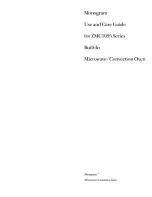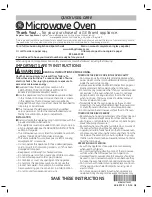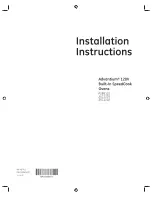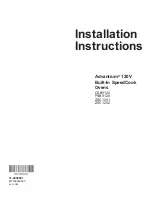
R307KW
8 – 1
R307KW
Service Manual
CHAPTER 8.
TEST PROCEDURES
[1] Procedure A: MAGNETRON ASSEMBLY TEST
1. Disconnect the power supply cord, and then remove outer case.
2. Open the door and block it open.
3. Discharge high voltage capacitor.
4. To test for an open filament, isolate the magnetron from the high voltage circuit. A continuity check across the magnetron filament leads should
indicate less than 1 ohm.
5. To test for a shorted magnetron, connect the ohmmeter leads between the magnetron filament leads and chassis ground. This test should indicate
an infinite resistance. If there is little or no resistance the magnetron is grounded and must be replaced.
6. Reconnect all leads removed from components during testing.
7. Reinstall the outer case (cabinet).
8. Reconnect the power supply cord after the outer case is installed.
9. Run the oven and check all functions.
1. MICROWAVE OUTPUT POWER
The following test procedure should be carried out with the microwave oven in a fully assembled condition (outer case fitted).
HIGH VOLTAGES ARE PRESENT DURING THE COOK CYCLE, SO EXTREME CAUTION SHOULD BE OBSERVED.
Power output of the magnetron can be measured by performing a water temperature rise test. This test should only be used if above tests do not indi-
cate a faulty magnetron and there is no defect in the following components or wiring: silicon rectifier, high voltage capacitor and power transformer.
This test will require a 16 ounce (453cc) measuring cup and an accurate mercury thermometer or thermocouple type temperature tester. For accurate
results, the following procedure must be followed carefully:
1. Fill the measuring cup with 16 oz. (453cc) of tap water and measure the temperature of the water with a thermometer or thermocouple tempera-
ture tester. Stir the thermometer or thermocouple through the water until the temperature stabilizes. Record the temperature of the water.
2. Place the cup of water in the oven. Operate oven at P-HI (100% Power) selecting more than 60 seconds cook time. Allow the water to heat for 60
seconds, measuring with a stop watch, second hand of a watch or the digital read-out countdown.
3. Remove the cup from the oven and again measure the temperature, making sure to stir the thermometer or thermocouple through the water until
the maximum temperature is recorded.
4. Subtract the cold water temperature from the hot water temperature. The normal result should be32.1 to 59.7
°
F(17.9 to 33.2
°
C) rise in tempera-
ture. If the water temperatures are accurately measured and tested for the required time period the test results will indicate if the magnetron tube
has low power output (low rise in water temperature) which would extend cooking time or high power output (high rise in water temperature) which
would reduce cooking time. Because cooking time can be adjusted to compensate for power output, the magnetron tube assembly should be
replaced only if the water temperature rise test indicates a power output well beyond the normal limits. The test is only accurate if the power supply
line voltage is 120 volts and the oven cavity is clean.
[2] Procedure B: POWER TRANSFORMER TEST
1. Disconnect the power supply cord, and then remove outer case.
2. Open the door and block it open.
3. Discharge high voltage capacitor.
4. Disconnect the primary input terminals and measure the resistance of the transformer with an ohmmeter. Check for continuity of the coils with an
ohmmeter. On the R x 1 scale, the resistance of the primary coil should be less than 1 ohm and the resistance of the high voltage coil should be
approximately 150 ohms (RTRN-A729WRZZ) or 125 ohms (RTRN-A730WRZZ); the resistance of the filament coil should be less than 1 ohm.
5. Reconnect all leads removed from components during testing.
6. Reinstall the outer case (cabinet).
7. Reconnect the power supply cord after the outer case is installed.
8. Run the oven and check all functions.
(HIGH VOLTAGES ARE PRESENT AT THE HIGH VOLTAGE TERMINAL, SO DO NOT ATTEMPT TO MEASURE THE FILAMENT AND HIGH
VOLTAGE.)
[3] Procedure C: HIGH VOLTAGE RECTIFIER TEST
1. Disconnect the power supply cord, and then remove outer case.
2. Open the door and block it open.
3. Discharge high voltage capacitor.
4. Isolate the rectifier from the circuit. Using the highest ohm scale of the meter, read the resistance across the terminals and observe, reverse the
leads to the rectifier terminals and observe meter reading. If a short is indicated in both directions, or if an infinite resistance is read in both direc-
tions, the rectifier is probably defective and should be replaced.
5. Reconnect all leads removed from components during testing.















































